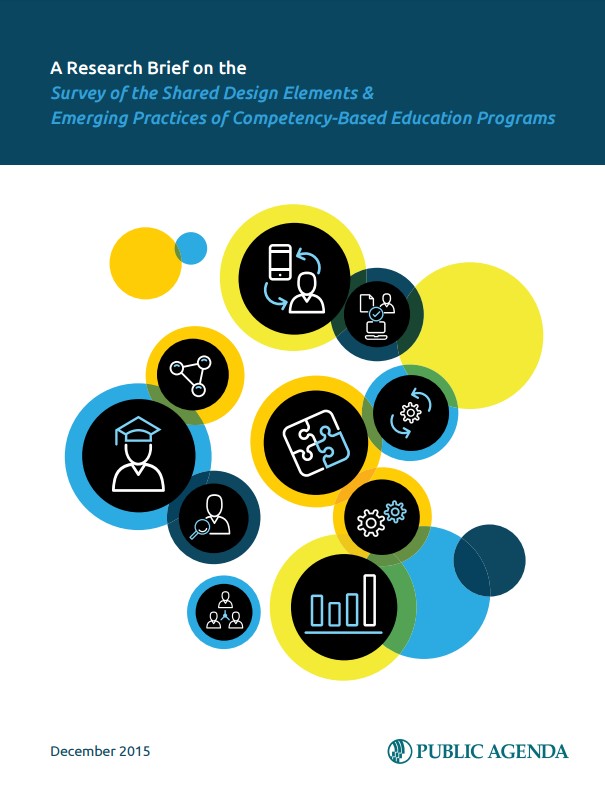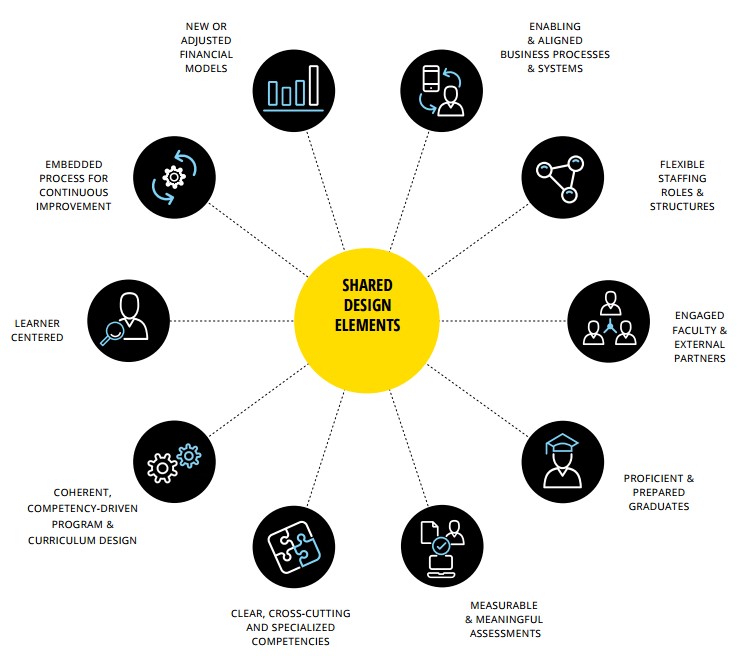During my tenure at Northern Arizona University, I was fortunate to have the opportunity to be part of the design and implementation team to move Personalized Learning, their competency-based initiative, forward. From idea to reality, it was a multi-stage, multi-faceted initiative.
In my current role, I have had the opportunity to connect with others who are planning or who have launched competency-based learning programs at their institutions. This has allowed me to reflect on my own personal experiences and balance that with insights gleaned from those at other institutions.
With all of that said, I read with interest the December, 2015 report from Public Agenda entitled “A Research Brief on the Survey of the Shared Design Elements & Emerging Practices of Competency-Based Education Programs”.
 Image: CBE Research Brief, Public Agenda
Image: CBE Research Brief, Public Agenda
To set the stage, page four of the report showcases the purpose of the study “to gather baseline data from competency-based education (CBE) programs”, provides highlights as to the study sample which included “754 individuals representing 586 programs” and the survey response rate which was “24%, with 324 individuals starting the survey and 179 individuals completing the survey”. The report states that “This is the largest-scale survey ever conducted on the state of practice of CBE in higher education in the United States.” (pg.4). What I also noted is that the respondents cut across the higher education landscape to include community colleges and research universities (and everything in between) as well as public, private, not-for-profit and for-profit institutions.
The study sample size is certainly consistent with the number of CBE programs highlighted in a September 10, 2015 story in Inside Higher Ed. Paul Fain noted that “Roughly 600 colleges are in the design phase for a new competency-based education program, are actively creating one or already have a program in place”.
In doing a deeper dive into the report (pg.6), I really appreciated the Shared Design Elements visual. In a complementary publication (Shared Design Elements Notebook) these elements and suggested practices were described as highlighting the “fullness of a CBE program, from organizational viability to the learning experience. Elements are broad and support diversity in practice. They are dynamic. Thriving CBE programs have all ten elements in place, but put into practice in different ways” (pg. 1).
 Image: Shared Design Elements Notebook, Public Agenda
Image: Shared Design Elements Notebook, Public Agenda
The elements are seen as necessary in designing and building a healthy and robust CBE program. I would certainly concur.
I appreciated that the report also highlights the importance of those elements by asking respondents how strongly they agree that the element is needed for a robust and healthy CBE program. The report also looks at the importance of the elements over time (e.g., top elements when starting a program).
Based on the experience of these respondents, primary barriers experienced by CBE programs were also highlighted. Here is an example from page 15:
 Image: CBE Research Brief, Public Agenda
Image: CBE Research Brief, Public Agenda
The insights here, didn’t surprise me at all! As institutions consider implementation timelines and strategies to mitigate challenges, having these insights from your colleagues will be incredibly valuable.
One point of reflection for me as I reviewed the report is that building a healthy and robust CBE program is just part of the equation. If I were to put on my enrollment management hat, the other part of this equation is the marketing, recruitment and onboarding of prospective learners into CBE programs. As we have found with online learning, MOOCs or other learning solutions…’one size doesn’t necessarily fit all’. So, I encourage your comments on the report as well as your CBE enrollment management insights.
If you are involved in a CBE initiative at your campus, I would encourage you to take a look at our Exploring Competency Based Education Workshop. Plus, check out our conferences as CBE has been a topic of interest at our some of our Collaborate conferences and Innovate and Accelerate conference sessions.
References
Fain, P. (2015, September 10). Keeping up with competency. Inside Higher Ed. Retrieved from https://www.insidehighered.com
Public Agenda (2015). A Research Brief on the Survey on the Shared Design Elements & Emerging Practices of Competency-Based Education Programs. Retrieved from http://www.publicagenda.org
Public Agenda (2015). Shared Design Elements and Emerging Practices of Competency-Based Education Programs. Retrieved from http://www.cbenetwork.org
About the Author
Karen L. Pedersen, Ph.D., Chief Knowledge Officer, Online Learning Consortium
Dr. Karen Pedersen was recently selected as the Chief Knowledge Officer for the Online Learning Consortium. In this role, she has responsibility to gather, curate and leverage the intellectual capital created by and disseminated through the organization to create and enhance services and resources provided to constituents.


